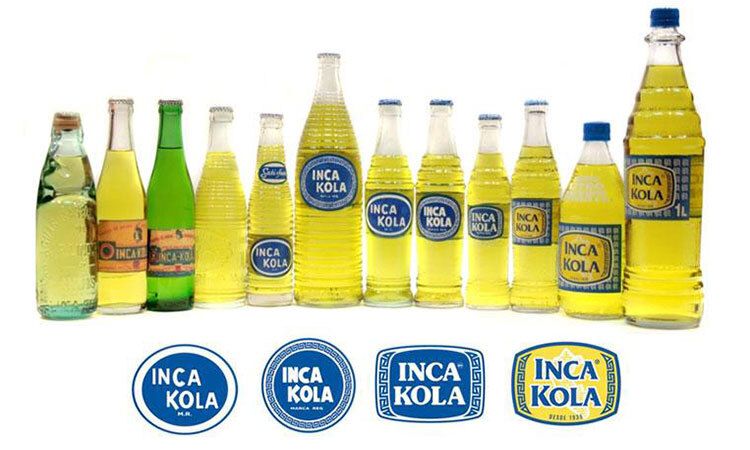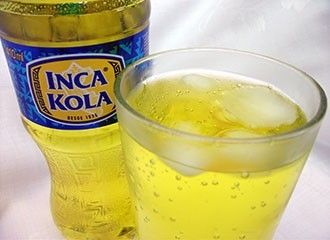Inca Kola is Peru’s most popular soft drink and, if we believe the advertisement, "El sabor del Peru" (The taste of Peru). A must try for every visitor or newbie in Peru.
The bright yellow, very sweet soda has a distinct and for many unusual fruity - some say “bubblegummy” - flavor which derives from one of its ingredients, lemon verbena. In Spanish speaking countries known as cedrón and in Peru as hierba luisa or verbena de Indias, this flowering plant is native to temperate zones in South America and common in Peru. It is used in homemade drinks and dishes including beverages, herbal teas, liqueurs, marinades for fish and poultry dishes, salsas, and jams, as well as in traditional medicine.
Anyway, Inca Kola is unique and a cultural icon in Peru. So, try it, best ice-cold; you either love it and are hooked or you hate it.
History of Inca Kola
The story begins at the end of the 19th and beginning of the 20th when Joseph Robinson Lindley (1859-1932) and his wife Martha Stoppanie emigrated from England to Peru. They first settled in what we know today as Lima’s city center, where they sold homemade (carbonated) fruit beverages to earn a living. In no time, the Lindley’s were known around town and their drinks enjoyed by everyone who tasted them.
In 1910, the Lindley family moved across the Rimac River, starting a small bottling company, the Fabrica de Aguas Gasificadas Santa Rosa, in Lima’s traditional working-class district Rimac with Joseph (now calling himself José) R. Lindley as general manager. The company did extremely well and already 8 years later the family bought their first semi-automated bottling system, increasing productivity dramatically while José R. Lindley sr. stepped down and turned the company over to his son José R. Lindley Stoppanie.
In 1928, further grown and with - for the time - highly modern production facilities and increased capacities, the company was renamed Santa Rosa de José R. Lindley e Hijos S.A. (Santa Rosa of José R. Lindley and Sons S.A.). By the early 1930s, the Lindley family produced and bottled a line of ten sodas created by the family including Cola Rosada, Orange Squash, Champagne Cola and Lemon Squash.
According to legend, in the early 1930s José Lindley jr. came across an infusion based on hierba luisa which he liked immensely. Having inherited the entrepreneurial spirit from his father, who unfortunately died in 1932, and most probably the creativity from his mother, he started to experiment with different typical soft drink ingredients adding hierba luisa, other plant derived flavors and different levels of carbonation until he came up with the perfect combination for a new and truly Peruvian soft drink.

And finally in 1935, just when Lima celebrated its 400th anniversary, Inca Kola was launched in the Peruvian capital with the slogan “Solo hay una y no se parece a ninguna” (There is only one, and it’s like no other). And the bright yellow soda hit the city like a bomb. By the mid-1940s, when Isaac R. Lindley, another son of the founder, assumed management of the company, Inca Kola was the top selling soft drink brand in Lima.
Now, under the name of Lindley Corporation (Corporación José R. Lindley S.A.), the company began to expand nationwide and started to distribute and market Inca Kola in Peru’s provinces. By the beginning of the 1970s, you could get Inca Kola everywhere in Peru from a little bodega in the Peruvian jungle to small eateries in the Andes to stores, supermarkets, and restaurants in the cities and along the Peruvian beaches; from 1995 even in fast-food restaurants such as Mc Donald’s and Bembos. Inca Kola was the number one soda in the country with a share of 30% to 38% of Peru’s soft drink market; and even the big player Coca Cola, who entered the Peruvian market already in 1936, couldn’t do anything about it. Even adding more sugar to the original Coke to cater to the sweet Peruvian tooth or the serious budget for creative advertising campaigns supposed to evoke happiness and celebration in Peru couldn’t change the mind of Peruvians. Coca Cola was the foreign company who couldn’t compete with the “Flavor of Peru” and, as Peruvians preferred to buy Peruvian, had to settle for second place.
However, in 1997, now under the reign of Johnny Lindley Taboada, a grandson of the founder and son of Isaac Lindley, who passed in 1989, the Lindley Corporation underwent restructuring and expansion, leaving the company in huge debt. Looking for outside financial support, Lindley considered a strategic alliance with his biggest competitor and turned to Coca Cola which in 1999 purchased 50% of the shares of the Inca Kola brand for an undisclosed amount (according to rumors anything between US$200 million and US$300 million). Additionally, Coca Cola became the sole owner of the Inca Kola trademark everywhere outside of Peru taking control of overseas marketing and production for the brand and furthermore took over 20% of the shares of the Lindley Corporation, the Lima bottler of Inca Kola and the largest bottler in the Inca Kola system. Inside Peru, a strategic partnership was negotiated and Johnny Lindley Taboada became the chairman of the joint venture and remained chairman of the bottling company.
With the signing of the contracts in 1999, the war between Coca Cola and Inca Kola came to an end. And while outsiders saw the partnership as a victory for Coca Cola finally bringing the Peruvian competitor to its knees, the Peruvian perspective was quite different. For decades, Coca Cola couldn’t convince Peruvians that their product was the better soft drink. And, when Coca Cola representatives were photographed drinking Inca Kola during a press conference announcing the joint venture, for Peruvians, this symbolized Coca Cola’s final defeat.
Today, Inca Kola is still the favorite soda of Peruvians. But not only the unique taste and different bright color was and still is the main factor for Inca Kola’s success. From its early beginning till today, the Lindley family managed to tie Inca Kola to the fervent patriotism of many Peruvians and the national identity. They linked their product to the amazing Peruvian past and the highly advanced Inca culture through its name and the design of its logo and created clever and modern, though simple and to Peruvians appealing marketing campaigns encouraging a sense of pride and belonging.
An ingenious strategy which made Inca Kola not only the most popular soft drink till today, but also a cultural icon in Peru and the “official soda” of the country.
Inca Cola Slogans over time
- 1935-1950: Solo hay una y no se parece a ninguna (There is only one, and it’s like no other)
- 1960-1980: La bebida del sabor nacional (The drink with the national flavor)
- 1980-1985: El sabor de la alegría (The taste of happiness)
- 1985-1989: La bebida del sabor nacional (The drink of national flavor)
- 1990-1995: Es nuestra, La bebida del Perú (It's ours, The drink of Peru)
- 1996-1999: Pide bien; que con todo combina (Order it, it goes with everything)
- 2000-2001: El sabor de lo nuestro (The taste of what is ours)
- 2001-2003: Hay una sola y el Perú sabe por qué (There is only one, and Peru knows why)
- 2003-2005: El sabor del Perú (The taste of Peru)
- 2005: Destapa el sabor del Perú (Uncap the flavor of Peru)
- 2005-2006: Celebra el Perú (Celebrate Peru)
- 2006: Qué buena idea (What a good idea)
- 2007: El sabor de la creatividad (The taste of creativity)
- 2008-2009: Todo es posible (Everything is possible)
- 2010: Inca Kola 75 años (Inca Kola: 75 years)
- 2015: Vamos por más (Let's go for more)
- 2016-2020: El sabor que nos hace únicos (The taste that makes us unique)
- 2021: Con creatividad el verano no para (With creativity, summer doesn't stop)
Popular mixed drinks and cocktails with Inca Kola
Inca Chilcano: while the traditional Chilcano is made of Peruvian Pisco, lime juice, sugar syrup and Ginger Ale, the Inca Chilcano substitutes the Ginger Ale with Inca Kola
Inca Wasi: Inca Kola mixed with Peruvian Pisco, sweet wine, chuchuhuasi (a liqueur from the Amazonian jungle region) and angostura bitters
Inca Dorada: Inca Kola either mixed with Peruvian Pisco and grapefruit juice or with
white rum and orange juice
Inca Punch: Inca Kola mixed with Peruvian Pisco, pineapple syrup, chicha morada and Aperol



























